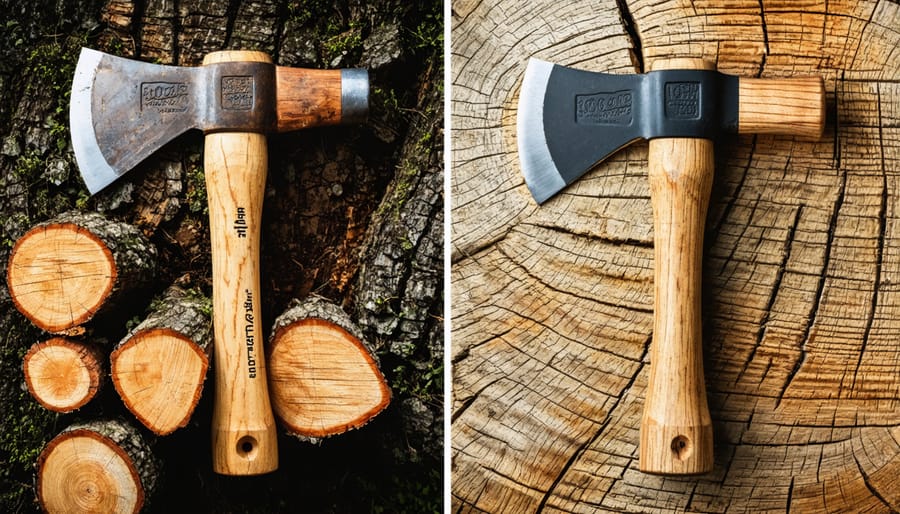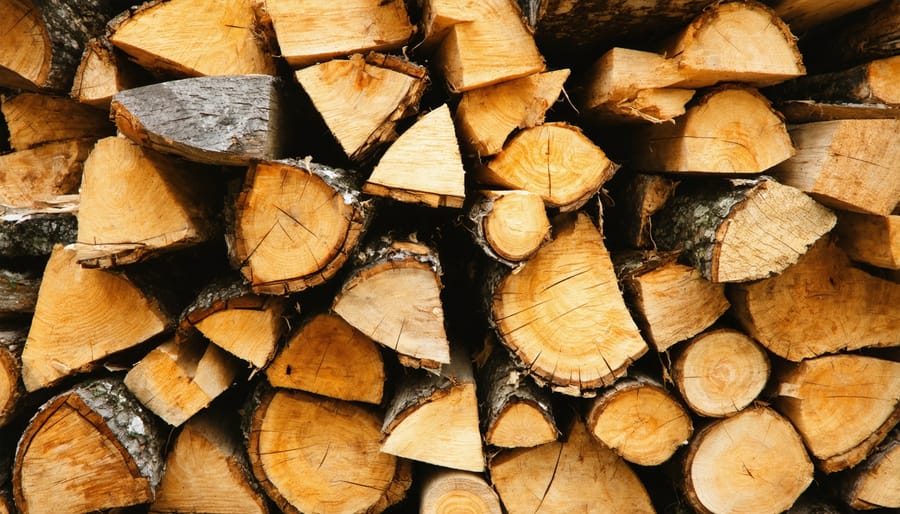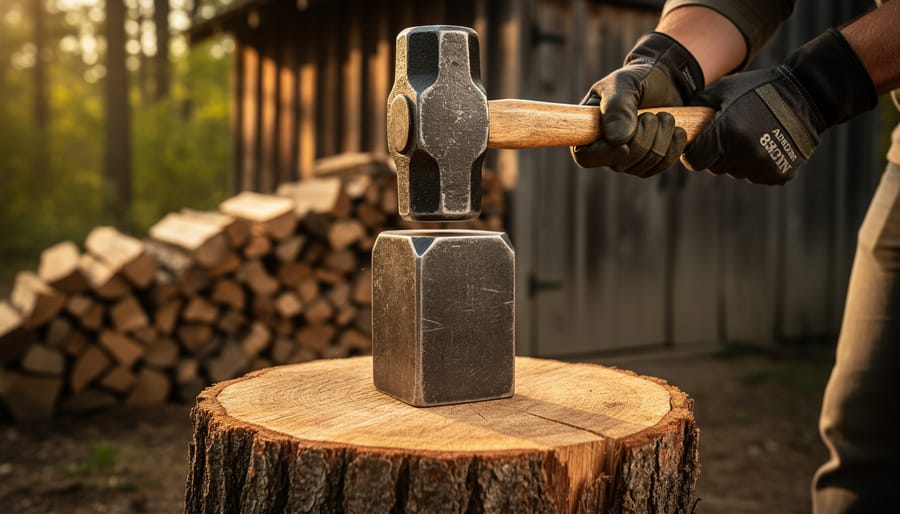Split wood with a single, well-placed strike rather than multiple blows by aiming for existing cracks and the outer edge of the round instead of dead center. Position your maul to follow the wood’s natural grain lines, which radiate from the center like wheel spokes, and you’ll use half the energy while doubling your productivity.
Choose a maul over an axe for hand splitting—the 6 to 8-pound splitting maul’s wedge-shaped head pushes wood fibers apart rather than cutting through them, making it far more effective for processing firewood. Match your tool weight to your strength and stamina; a lighter maul you can swing confidently for an hour outperforms a heavy one that exhausts you after twenty minutes.
Set up your splitting area on a wide chopping block that positions the wood at shin height, saving your back and creating a stable surface that absorbs impact. This simple foundation transforms splitting from a grueling chore into a sustainable rhythm you can maintain throughout the season.
Master the technique that professional wood cutters use: let the maul’s weight do the work by raising it overhead and guiding it down in a controlled arc, accelerating through the strike point. Your hands should slide naturally down the handle as you swing, with your dominant hand moving toward the head for maximum power transfer. This approach delivers consistent results while minimizing fatigue and injury risk, turning your wood splitting sessions into satisfying preparation for cozy evenings by your fireplace.
Why Hand Splitting Still Makes Sense in a Power Tool World
In our modern world filled with gas-powered splitters and hydraulic machines, there’s something wonderfully refreshing about the rhythmic swing of a maul connecting with wood. Hand splitting isn’t just a nostalgic throwback—it offers genuine advantages that matter to homeowners seeking a more connected, sustainable lifestyle.
The most immediate benefit? Silence. There’s no engine roar disturbing your peaceful morning or annoying the neighbors. Just the satisfying crack of wood fibers separating and the ambient sounds of nature around you. This quiet operation means you can split wood early or late without creating a disturbance, fitting the work into your schedule rather than planning around acceptable noise hours.
Your wallet will appreciate hand splitting too. Once you’ve invested in quality tools, there are no ongoing fuel costs, no maintenance bills, and no mechanical breakdowns at the worst possible moment. The tools are remarkably reliable and require minimal care beyond keeping edges sharp and handles secure.
Let’s talk about the exercise component. Splitting wood by hand is a full-body workout that builds functional strength, improves cardiovascular health, and burns significant calories. It’s honest physical work that leaves you tired in the best way—the kind that makes a warm fire feel truly earned.
Hand splitting also offers incredible flexibility. No electricity required means you can process wood wherever it falls. Working at a remote property or cabin? No problem. Your tools are portable, lightweight, and always ready.
Of course, power tool alternatives make perfect sense when you’re processing several cords annually or dealing with exceptionally tough wood. The key is matching the method to your needs, volume, and personal preferences. For many homeowners burning a cord or two each winter, hand splitting provides exercise, satisfaction, and a mindful break from our plugged-in world.
The Essential Tools You Actually Need
The Splitting Maul vs. The Splitting Axe
When you’re ready to commit to hand-splitting wood for your fireplace, understanding the splitting maul vs. axe debate will help you choose the right tool for your needs.
A splitting maul is the heavier option, typically weighing between 6 to 12 pounds, with a wedge-shaped head designed to push wood fibers apart rather than cut through them. This heft makes it ideal for tackling large, stubborn rounds and knotty pieces that require serious splitting power. The weight does the work for you, though it demands more energy to swing.
A splitting axe, on the other hand, usually weighs 3 to 6 pounds and features a sharper blade angle. It’s perfect for smaller to medium-sized logs and offers better control with less fatigue during extended splitting sessions. The lighter weight makes it easier to maintain proper form throughout your work.
For beginners, starting with a 6-pound splitting axe often makes the most sense. It provides enough splitting force for most firewood while allowing you to develop proper technique without exhaustion. As your skill and strength improve, you might add a heavier maul to your collection for those challenging pieces.
Consider your typical wood supply too. If you’re primarily splitting straight-grained, medium-diameter logs from sustainable forestry practices, an axe handles the job beautifully. But if you’re processing larger rounds or tough species, a maul becomes your essential companion for keeping your home warm throughout the heating season.

Wedges and Sledgehammers for Tough Logs
Sometimes you’ll encounter logs that simply refuse to cooperate with your maul alone. That’s when understanding the partnership between wedges and mauls becomes essential for your firewood preparation routine.
Wedges shine when you’re dealing with large-diameter rounds over 16 inches or particularly stubborn wood with interlocking grain. Start by making an initial strike with your maul to create a small crack in the log. Position your first wedge in this crack, about two inches from the edge rather than dead center. This edge placement gives you better leverage and prevents the wedge from getting stuck.
Drive the wedge in with steady sledgehammer blows until you see the crack begin to widen. If progress stalls, add a second wedge about six inches away from the first, working progressively across the log’s face. This technique distributes the splitting force more effectively than trying to force one wedge through the entire diameter.
For truly challenging pieces, three wedges positioned in a triangular pattern can work wonders. This approach transforms a seemingly impossible splitting task into a manageable one, keeping your firewood supply flowing smoothly for those cozy evenings by the hearth.
Safety Gear That Actually Matters
Let’s talk about staying safe while you build your firewood supply. The right safety gear makes splitting wood genuinely enjoyable rather than anxiety-inducing.
Steel-toed boots are non-negotiable. A dropped maul or deflected log can cause serious foot injuries, and proper footwear gives you stability on uneven ground. Safety glasses protect against flying wood chips and bark fragments that inevitably come your way—trust me, you’ll appreciate them after your first splitting session.
Now, about gloves: they’re helpful for preventing blisters during extended sessions, but many experienced splitters prefer bare hands for better grip control. If you do wear gloves, choose ones that fit snugly without bunching. Loose gloves can actually reduce your control and create hazards.
Keep your splitting area clear of obstacles and maintain a safety zone where others, especially children and pets, stay back at least ten feet. Good safety practices mean you’ll spend more time enjoying your wood-burning fireplace and less time worrying about accidents. When you’re confident in your safety setup, splitting becomes a satisfying rhythm rather than a stressful chore.
How to Read Your Wood Before You Swing
Before you raise that maul, take a moment to read your wood like a book. Those logs hold valuable clues that can make the difference between a satisfying split and a frustrating struggle. Learning to assess each piece before you swing transforms wood splitting from pure brute force into strategic, efficient work.
Start by examining the grain direction. Look at the end of the log where you can see the growth rings. The grain runs vertically through the wood, and you always want to split with the grain, never against it. Think of it like tearing paper—it’s easy to rip along the perforation, nearly impossible to tear across it. Position your log so you’re splitting in line with those natural fibers.
Next, scan for knots, branches, and crotches where the trunk divided. These are your natural enemies in wood splitting. Knots are incredibly dense and can deflect your maul or wedge, wasting energy and potentially damaging your tools. Whenever possible, avoid splitting directly through knots. If you must tackle a knotty piece, aim for spots between the knots or use wedges to work around them gradually.
Wood species matters significantly. Some woods, like ash and oak, split cleanly with satisfying ease. Others, like elm and sweet gum, have twisted, interlocking grain that fights you at every swing. These difficult species often require wedges and patience rather than repeated maul strikes. Understanding what you’re working with helps set realistic expectations and prevents unnecessary frustration.
Finally, check moisture content. Green wood, freshly cut with high moisture, actually splits easier than seasoned wood because the fibers haven’t bonded as tightly through drying. However, you’ll want to split it promptly and then let it season for your fireplace. That partially dried sweetspot exists too—wood that’s been sitting a few months but isn’t bone-dry yet. Extremely dry wood can be stubborn and may require more force. By reading these signs, you’re working smarter, conserving energy for a productive splitting session that keeps your firewood supply abundant.

The Proper Technique That Saves Your Energy and Your Back
Setting Up Your Splitting Block
Your splitting block creates the foundation for safe, effective wood splitting. Think of it as your workstation—get this right, and everything else becomes easier.
The ideal height positions your target log between knee and mid-thigh level. This sweet spot allows you to swing with natural momentum while keeping your back straight and comfortable. Too high, and you’ll tire quickly from awkward angles. Too low, and you’re inviting back strain and missed strikes.
For your block itself, choose a sturdy round of hardwood, at least 12 inches in diameter and 16-20 inches tall. Elm, oak, or maple work beautifully. The block absorbs impact, protects your axe edge, and prevents dangerous bounces on hard ground. Position it on level, stable ground away from windows, vehicles, and foot traffic.
When placing logs on your block, stand them upright with any visible cracks facing outward—this is where your axe will naturally want to travel. Center smaller pieces directly on the block. For larger rounds, let them overhang slightly on the side facing you; this creates a cleaner splitting angle and reduces the chance of your axe getting stuck.
Take a moment to clear debris and ensure solid footing around your workspace. These small preparations make splitting safer and transform what could be tedious work into a satisfying rhythm that reliably stocks your fireside.
The Stance and Swing That Protects Your Body
The secret to splitting wood effectively isn’t about channeling your inner lumberjack with brute force. It’s about working smarter, not harder, by letting physics do the heavy lifting while you guide the process.
Start with your feet positioned shoulder-width apart, standing stable and balanced. Place your non-dominant foot slightly forward, creating a comfortable athletic stance that allows your body to rotate naturally. Position yourself about one arm’s length from the chopping block, giving your swing room to develop momentum without overreaching.
Your grip matters more than you might think. Hold the maul with both hands on the handle, keeping them together near the bottom. As you begin your upward swing, slide your dominant hand up the handle toward the maul head. This sliding motion creates a smooth, controlled arc and prevents jarring impact on your joints.
The swing itself should feel almost effortless. Raise the maul overhead, allowing it to reach back slightly behind your head at the top of the arc. As you bring it down, let gravity accelerate the maul head while you guide its path. Your dominant hand slides back down to meet your other hand just before impact, adding control and power at the precise moment you need it.
Focus on your follow-through. Don’t try to stop the maul at the point of contact. Instead, aim to split through the wood, letting the momentum carry the blade all the way to the chopping block. This complete follow-through protects your shoulders and back from absorbing the shock while maximizing splitting efficiency. Your body should rotate naturally through the movement, engaging your core and legs rather than straining your arms and back.

Aiming for Success: Where to Strike
The secret to efficient wood splitting isn’t brute strength, but rather smart targeting. Think of it like finding the path of least resistance in your wood.
Start by examining your log carefully. Look for existing cracks or checks running along the surface. These natural weak points are your best friends. Position your log so you can strike directly along these lines, as they’ll guide your axe or maul through the wood with far less effort.
Contrary to what many beginners assume, aiming for the center of a log is actually the hardest approach. Instead, target the outer edges, working your way around the circumference. This technique takes advantage of the wood’s natural structure and requires significantly less force. For larger rounds, consider making several edge strikes to create wedge-shaped pieces rather than attempting to halve the entire log in one swing.
Different wood types demand adjusted strategies. Straight-grained woods like ash and oak split predictably along their fibers, while twisted or knotty pieces require more patience and strategic placement. With gnarly sections, look for the straightest grain path available. Smaller logs under six inches often respond well to a single centered strike, while anything larger benefits from the edge-targeting approach. Remember, working with your wood’s natural characteristics rather than against them transforms splitting from exhausting work into a satisfying rhythm that keeps your fireplace well-stocked all season long.
Smart Strategies for Different Wood Types
Not all firewood behaves the same way under your maul, and understanding these differences will save you time and frustration while building your woodpile. Your success with hand splitting largely depends on matching your technique to the wood species you’re working with.
The easiest woods to split are your new best friends. Ash stands out as the champion of splitting ease, with straight grain that practically falls apart with minimal effort. White oak, once properly seasoned, splits beautifully along its natural grain lines. Black cherry and maple also cooperate nicely, making them ideal choices if you’re just developing your splitting skills. These woods reward good technique and make the whole process feel satisfying rather than exhausting.
On the opposite end of the spectrum, some species will test your patience and technique. Elm tops the list of troublesome woods, with interlocking grain that seems designed to defy your maul. Sweetgum presents similar challenges, often refusing to split cleanly. If you’re dealing with these difficult characters, patience becomes your greatest asset. Focus on finding natural cracks and work from the edges rather than attacking the center. Sometimes allowing these woods to dry longer helps, though elm remains stubborn regardless.
Regional variations matter too. What’s common firewood in New England differs from what’s available in the Pacific Northwest or the South. Get to know your local wood suppliers and ask about the species they offer. Building relationships with tree services in your area can also provide opportunities to source specific types that match your skill level.
For those challenging pieces that just won’t cooperate, remember that not every log needs to be conquered. Sometimes it’s perfectly acceptable to set aside the most stubborn rounds for a different day or even use them whole if your fireplace accommodates larger pieces. The goal is sustainable, enjoyable firewood preparation that keeps your home warm throughout the season.
When Your Log Won’t Cooperate: Troubleshooting Tough Splits
Even experienced wood splitters encounter stubborn logs that seem determined to keep their secrets. When your maul bounces back or gets stuck, don’t let frustration win—there’s usually a smart solution.
If your maul gets wedged in a log, resist the urge to yank it out violently. Instead, lift the entire log with the maul still embedded and strike the maul’s poll (back end) against your chopping block. The log’s own weight will help drive the split through. For particularly stubborn pieces, this is where using wedges effectively becomes invaluable—they let you attack the problem from multiple angles.
Twisted grain logs are nature’s puzzle boxes. Look for the path of least resistance by examining the log’s ends for natural cracks or checks. Start your split there rather than forcing through the tightest grain. Sometimes rotating the log 90 degrees and trying a perpendicular approach works wonders.
Knotty sections deserve special respect. The wood around knots is incredibly dense and tough. If possible, position your strike to avoid knots entirely, aiming for the clear wood between them. When that’s impossible, multiple smaller strikes around the knot’s perimeter often work better than one mighty blow.
Frozen wood in winter presents its own challenges—it’s harder and more brittle. Let rounds warm up in your garage for a day or two before splitting, or plan your splitting sessions for late afternoon when wood has absorbed some sunshine.
Here’s the wisdom many beginners need to hear: not every log is worth the battle. If you’ve made several solid attempts without progress, set it aside. Life’s too short to wage war with one ornery piece when you have a whole pile waiting. That stubborn round might split easily after another season of drying, or it could become a perfect candidate for your fire pit where its gnarly character won’t matter.
Making Hand Splitting Part of Your Firewood Routine
Making hand splitting part of your regular firewood routine transforms this rewarding task from an occasional chore into an efficient, enjoyable rhythm that supports your home heating goals throughout the year.
The key to success lies in timing. Split wood when it’s freshly cut and green—the moisture content makes the fibers separate more easily, reducing the effort required. Fresh-cut logs split with noticeably less resistance than dried wood, where the fibers have contracted and hardened. Aim to split your firewood in late winter or early spring, giving it the full spring and summer to season properly before the next heating season begins.
Create a workflow that minimizes wasted motion. Position your splitting area between your log pile and stacking location, keeping everything within easy reach. Split in sessions that match your energy level—even 30 minutes of focused splitting several times weekly builds your supply steadily without exhaustion. This approach also turns splitting into a pleasant break from sedentary activities rather than an overwhelming weekend project.
As you split, stack immediately using proper techniques that promote airflow. Stack wood bark-side up in rows with space between pieces, elevated off the ground, and protected from rain while allowing sun and wind to do their seasoning work. This integrated approach means you handle each piece just twice—once to split, once to carry indoors.
Tool maintenance completes your routine. After each session, wipe down your axe or maul, checking for loose handles or dulling edges. Sharpen blades seasonally and oil wooden handles to prevent cracking. Well-maintained tools make each splitting session safer and more efficient, ensuring this sustainable practice remains a satisfying part of your fireside lifestyle for years to come.

Starting your hand-splitting journey doesn’t require perfection from day one. Begin with a modest pile of wood, perhaps just enough for a weekend’s worth of fires, and let your skills develop naturally with each swing. You’ll find that what feels awkward at first soon becomes a satisfying rhythm, and those early struggles transform into confident, efficient movements.
The beauty of hand splitting lies not just in the physical wood you prepare, but in the entire experience it brings to your home heating routine. There’s something deeply rewarding about stacking wood you’ve split yourself, knowing that each piece represents your effort and growing expertise. This traditional skill connects you to generations of homeowners who’ve found independence and satisfaction in providing their own heat.
Yes, there’s a learning curve, and your muscles might protest initially. But as you develop your technique, you’ll discover that hand splitting becomes less about brute force and more about understanding wood grain, timing, and efficiency. You’re not just preparing fuel for your fireplace; you’re embracing a sustainable, hands-on approach to home heating that reduces your environmental footprint while building genuine self-reliance. Pick up that maul, start with realistic goals, and enjoy becoming part of this timeless craft.






